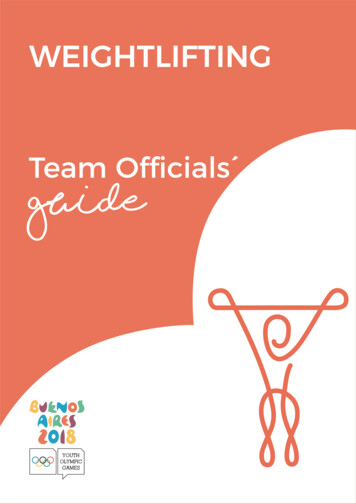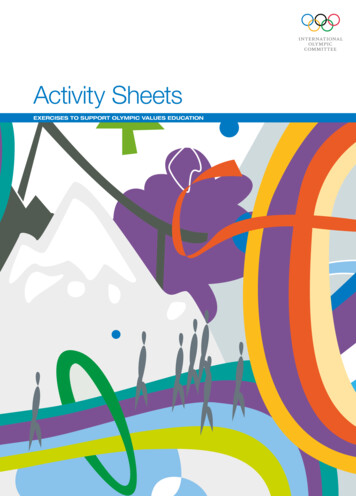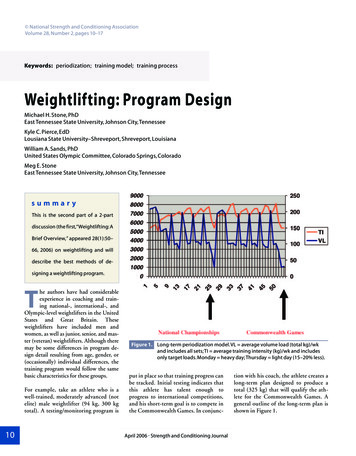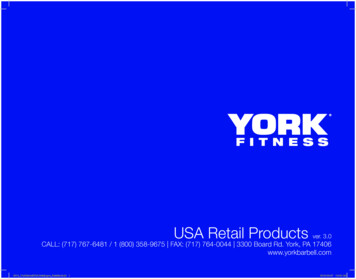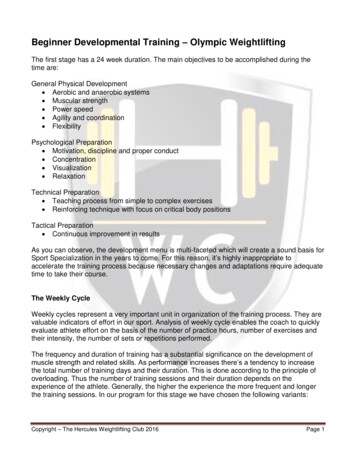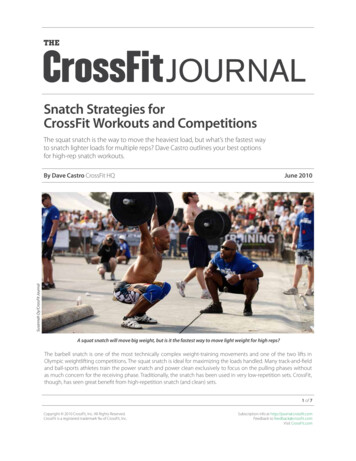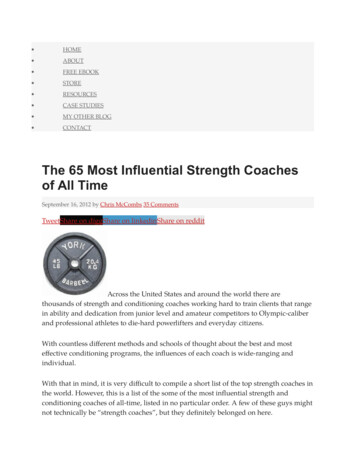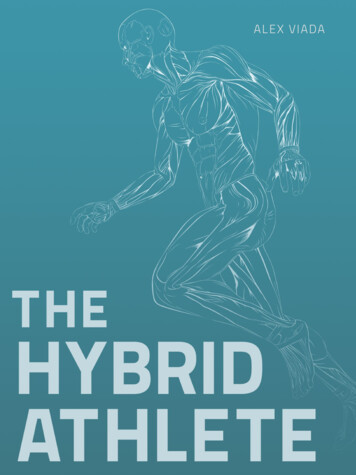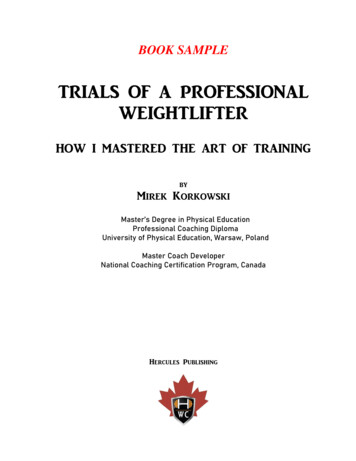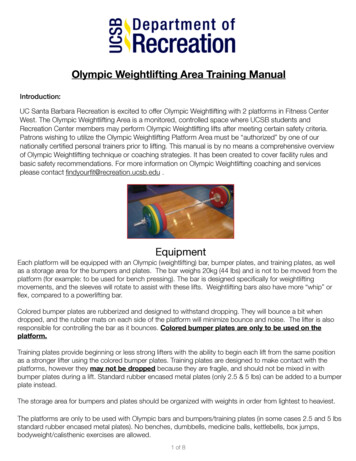
Transcription
Olympic Weightlifting Area Training ManualIntroduction:UC Santa Barbara Recreation is excited to offer Olympic Weightlifting with 2 platforms in Fitness CenterWest. The Olympic Weightlifting Area is a monitored, controlled space where UCSB students andRecreation Center members may perform Olympic Weightlifting lifts after meeting certain safety criteria.Patrons wishing to utilize the Olympic Weightlifting Platform Area must be “authorized” by one of ournationally certified personal trainers prior to lifting. This manual is by no means a comprehensive overviewof Olympic Weightlifting technique or coaching strategies. It has been created to cover facility rules andbasic safety recommendations. For more information on Olympic Weightlifting coaching and servicesplease contact findyourfit@recreation.ucsb.edu .EquipmentEach platform will be equipped with an Olympic (weightlifting) bar, bumper plates, and training plates, as wellas a storage area for the bumpers and plates. The bar weighs 20kg (44 lbs) and is not to be moved from theplatform (for example: to be used for bench pressing). The bar is designed specifically for weightliftingmovements, and the sleeves will rotate to assist with these lifts. Weightlifting bars also have more “whip” orflex, compared to a powerlifting bar.Colored bumper plates are rubberized and designed to withstand dropping. They will bounce a bit whendropped, and the rubber mats on each side of the platform will minimize bounce and noise. The lifter is alsoresponsible for controlling the bar as it bounces. Colored bumper plates are only to be used on theplatform.Training plates provide beginning or less strong lifters with the ability to begin each lift from the same positionas a stronger lifter using the colored bumper plates. Training plates are designed to make contact with theplatforms, however they may not be dropped because they are fragile, and should not be mixed in withbumper plates during a lift. Standard rubber encased metal plates (only 2.5 & 5 lbs) can be added to a bumperplate instead.The storage area for bumpers and plates should be organized with weights in order from lightest to heaviest.The platforms are only to be used with Olympic bars and bumpers/training plates (in some cases 2.5 and 5 lbsstandard rubber encased metal plates). No benches, dumbbells, medicine balls, kettlebells, box jumps,bodyweight/calisthenic exercises are allowed.1 of 8
Participant Inspection- Bar sleeves are self-lubricating.- Staff will clean the bars with True 7. Please check prior to use that the bar is dry.- Along with staff doing hourly platform checks, please visually inspected the platform area assuringthere is no damage to bars, platforms, or bumper plates. Please notify a staff member if you noticedamages to any of the equipment.- Please rack bumper plates in order from lightest to heaviest (left to right, prior to returning ID card).- Blood on the bars or platforms from scraping the shins is possible. Inspect the bars before and afteruse. If you notice blood on the bar, please notify a fitness center staff member who will clean the barand/or platform as needed according to the normal blood borne pathogen protocol.Examples of Approved FC2 Platform Area Olympic LiftsClean (Power clean, hangclean, full or “squat” clean)Snatch (Power snatch, hangsnatch, full or “squat” snatch)2 of 8
Clean and JerkCLEAN LIFTER (THEN STANDS UPSTRAIGHT)JERKFRONT SQUAT (LIFTER SHOULDKNOW HOW TO BAIL OUT IF HE/SHE CAN’T STAND UP W/ THEWEIGHT).OVERHEAD SQUAT,BOTTOM POSITION3 of 8
Pulls (clean or snatch grip)FRONT VIEW (SNATCHGRIP)SIDE VIEWPush press, push (or power) jerk, split jerkENDING POSITION OF APUSH PRESS OR PUSH JERKENDING POSITION OF SPLITJERK (FEET ARE “SPLIT” APART,NOT PARALLEL)4 of 8
GripsStandard or “opposing”grip.Beginning of the “hook”grip.Final position of the hookgrip.Thumbless grip(unacceptable).Safety and SpottingDue to the dynamic nature of most of these lifts, spotting is not allowed while on the platforms.Instead, the lifter must know how to “miss” a lift. Because a missed lift might entail the bargoing from overhead to the platform either in front or behind the lifter, it is vital that otherpatrons in the area do not take shortcuts using the platforms when another patron is lifting. Ifpatrons are lifting in a group (3 per platform max), all platform users waiting for their turn mustremain alert and in a safe area with eyes and attention on the lifter. Safe areas for waitinginclude the far rear of the platform area closest to the dumbbells.Examples of Missed LiftsMISSED LIFT EXAMPLES-MOSTLIKELY A MISSED SNATCHMISSED JERK5 of 8
When missing forward, the lifter pushes the bar forward onstraight arms and pulls the knees back to drop the barforward safely.The stick overhead in atypical split jerk position.When missing backward, the lifter pushes back on straightarms and jumps forward to drop the bar behind safely (thehands open to release the bar to fall freely when the barhas reached approximately the position shown, or slightlylower).The stick has travelled too farbehind the shoulders and hips tobe controlled safely so the lifterwill push it back on straight armsand pull the back arm forward, outof the way of the falling bar.*USAW Weightlifting Safety Recommendations6 of 8Here the stick is too far forward,so the lifter will push it furtherforward on straight arms and pullthe front foot back, out of the wayof the falling bar.
ExerciseGood TechniquePoor TechniqueClean Deadlift(start of clean) Bar against shins Feet flat Shoulders in line orin front of bar Lower back“flat” (neutral spine) Upper back flat/chest up (scapulaeretracted) Feet are in idealvertical jump stance Roughly a shoulderwidth grip Bar not in contact w/shins Heels up Shoulders behind bar Upper OR lower backrounded Feet too close or toofar apartFirst Pull (from floorto knee level) Shoulders, kneesand hips move atthe same rate Back stays flat/tight Bar stays close tolegs-knees willnaturally movebackward to avoidcontact Rounded back Hips move first Knees don’t extendon time, resulting inscraping shins w/barSecond Pull (fromknee level to chest/shoulder level) Bar stays close to Bar swings forwardlegs/bodyaway from body Arms start to bend Arms already bentas a result ofbefore bar passesshrugging thekneesshoulders as the “Reverse curling” thelifter extends hipsbarand pushes off floorw/balls of feet Bar should brushagainst lifter’s upperthighs Elbows stay abovebar until turnoverand catch. Feet jump out tosquatting widthThe Catch (or “rack”) Bar stays close tobodyLifter starts to drop Elbows whipunderneath the barunderneath and into catch on clavicle/front of bardeltoid region Elbows pointforward (as much aspossible) Bar swings forward Reverse curling thebar Elbows not elevatedin the catch Feet jump out toextreme wide stancein order for lifter tocatch the bar7 of 8Notes
ExerciseGood TechniqueFront Squat (if doing Elbows stay up andforwardfull clean) Lifter squats toparallel or below Back stays tightJerkAfter standingupright, lifter thendips and drives baroverhead whilesplitting legs front/back. Initiate lift with smalldip in knees Torso stays vertical Lifter transferspower from legs tobar to finishoverhead w/straightarms Legs split with bothknees bentPoor TechniqueNotes Elbows drop Upper back rounds Torso angles forward Back leg straight atend of jerk Back heel on groundat end of jerk Bar not over “crown”of head at end of jerk Some lifters may do apush jerk instead, wherelegs do not split. Recovery from jerk entailsmoving front leg a halfstep back, then the backleg a half step forwardbefore lowering bar toshoulders.Want to learn more about olympic weightlifting?The Recreation Department offers 8 week olympic weightlifting classes, small group personal trainingand one on one personal training sessions. Please see our current list of class offerings atregister.recreation.ucsb.edu or email findyourfit@recreation.umail.edu to learn more.8 of 8
nationally certified personal trainers prior to lifting. This manual is by no means a comprehensive overview of Olympic Weightlifting technique or coaching strategies. It has been created to cover facility rules and basic safety recommendations. For more information on Oly
